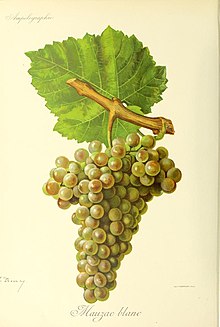
Chardonnay is a green-skinned grape variety used in the production of white wine. The variety originated in the Burgundy wine region of eastern France, but is now grown wherever wine is produced, from England to New Zealand. For new and developing wine regions, growing Chardonnay is seen as a 'rite of passage' and an easy entry into the international wine market.

Sparkling wine is a wine with significant levels of carbon dioxide in it, making it fizzy. While it is common to refer to this as champagne, European Union countries legally reserve that word for products exclusively produced in the Champagne region of France. Sparkling wine is usually either white or rosé, but there are examples of red sparkling wines such as the Italian Brachetto, Bonarda and Lambrusco, and the Australian sparkling Shiraz. The sweetness of sparkling wine can range from very dry brut styles to sweeter doux varieties.

Chenin blanc is a white wine grape variety from the Loire Valley of France. Its high acidity means it can be used to make varieties from sparkling wines to well-balanced dessert wines, although it can produce very bland, neutral wines if the vine's natural vigor is not controlled. Outside the Loire, it is found in most of the New World wine regions; it is the most widely planted variety in South Africa, where it was historically also known as Steen. The grape may have been one of the first to be grown in South Africa by Jan van Riebeeck in 1655, or it may have come to that country with Huguenots fleeing France after the revocation of the Edict of Nantes in 1685. Chenin blanc was often misidentified in Australia, as well, so tracing its early history in the country is not easy. It may have been introduced in James Busby's collection of 1832, but C. Waterhouse was growing Steen at Highercombe in Houghton, South Australia, by 1862.
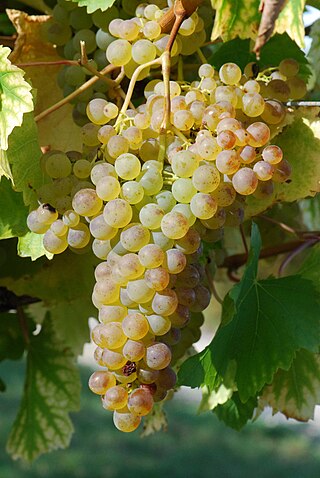
Colombard is a white French wine grape variety that may be the offspring of Chenin blanc and Gouais blanc. This makes the grape the sibling of the Armagnac Meslier-Saint-François and the nearly extinct Cognac grape Balzac blanc.

Aligoté is a white grape used to make dry white wines, especially in the Burgundy region of France where it was first recorded in the 18th century. Since it is tolerant to cold, this variety is also cultivated in Eastern European countries. In 2004, it was the 22nd most planted vine variety in the world at 45,000 hectares.

Limoux is a commune and subprefecture in the Aude department, a part of the ancient Languedoc province and the present-day Occitanie region in southern France. Its vineyards are famous for being first to produce sparkling wine known as Blanquette de Limoux.

Jura wine is French wine produced in the Jura département. Located between Burgundy and Switzerland, this cool climate wine region produces wines with some similarity to Burgundy and Swiss wine. Jura wines are distinctive and unusual wines, the most famous being vin jaune, which is made by a similar process to Sherry, developing under a flor-like strain of yeast. This is made from the local Savagnin grape variety. Other grape varieties include Poulsard, Trousseau, and Chardonnay. Other wine styles found in Jura includes a vin de paille made from Chardonnay, Poulsard and Savagnin, a sparkling Crémant du Jura made from slightly unripe Chardonnay grapes, and a vin de liqueur known as Macvin du Jura made by adding marc to halt fermentation. The renowned French chemist and biologist Louis Pasteur was born and raised in the Jura region and owned a vineyard near Arbois.

Clairette blanche is a white wine grape variety most widely grown in the wine regions of Provence, Rhône and Languedoc in France. At the end of the 1990s, there were 3,000 hectares of Clairette blanche grown in France, although volumes are decreasing.

Languedoc-Roussillon wine, including the vin de pays labeled Vin de Pays d'Oc, is produced in southern France. While "Languedoc" can refer to a specific historic region of France and Northern Catalonia, usage since the 20th century has primarily referred to the northern part of the Languedoc-Roussillon region of France, an area which spans the Mediterranean coastline from the French border with Spain to the region of Provence. The area has around 700,000 acres (2,800 km2) under vines and is the single biggest wine-producing region in the world, being responsible for more than a third of France's total wine production. In 2001, the region produced more wine than the United States.
Pineau d'Aunis is a red French wine grape variety that is grown primarily in the Loire Valley around Anjou and Touraine.

Négrette is a dark red wine grape grown primarily in South West France in the region between Albi and Toulouse.
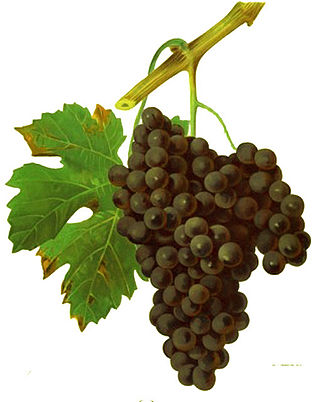
Duras is a traditional French variety of red wine grape that is mostly grown around the river Tarn, northeast of Toulouse. It is usually blended with other traditional varieties, but production has been declining in recent years.
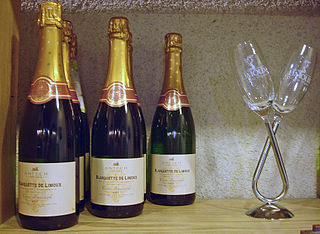
Limoux wine is produced around the city of Limoux in Languedoc in southwestern France. Limoux wine is produced under four Appellation d'origine contrôlée (AOC) designations: Blanquette de Limoux, Blanquette méthode ancestrale, Crémant de Limoux and Limoux, the first three of which are sparkling wines and dominate the production around Limoux. The main grape of the region is the Mauzac, locally known as Blanquette, followed by Chardonnay and Chenin blanc. In 2005, the Limoux AOC was created to include red wine production consisting of mostly Merlot. Wine historians believe that the world's first sparkling wine was produced in this region in 1531, by the monks at the abbey in Saint-Hilaire.
Meslier Petit is a rare white wine grape that is a minor component of some Champagne blends. It is valued for its ability to retain acidity even in hot vintages. In the very rare cases where it is not blended, it makes crisp wines tasting of apples. The Traminer family of grapes can be difficult to grow, with poor disease resistance and low yields.
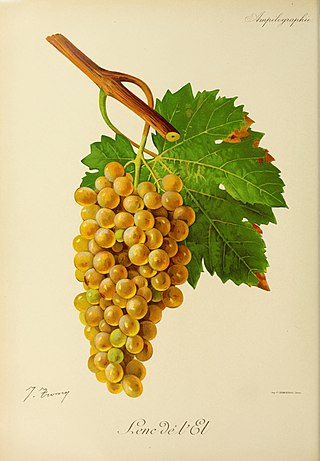
Len de l'El is a white French wine grape variety native to South West France. Appellation d'origine contrôlée (AOC) regulation dictate that the white wines from Gaillac must include at least 15% Len de l'El blended with Mauzac, though there has been movements to allow substitution of Sauvignon blanc.

Ondenc is a white French wine grape found predominantly in the Gaillac region of southwest France. In the 19th century, it was a popular planting in Bordeaux but fell out of favor following the phylloxera epidemic due to poor yields and sensitivity to grape disease, though is still one of the seven white varieties permitted in Bordeaux. Prior to falling out of favor, vine cuttings were brought from Bordeaux to Australia where the grapes became known under the synonyms of Irvine's White in Victoria and Sercial in South Australia. The Australian grapes weren't identified as Ondenc till 1976 when French ampelographer Paul Truel identified the vine while visiting Australia. Today, the grape is nearly extinct in Australia except for a small amount of plantings in Victoria used in sparkling wine production.

Incrocio Manzoni or Manzoni grapes is a family of grape varieties named after Professor Luigi Manzoni (1888-1968) of Italy's oldest school of oenology located in Conegliano, in the Veneto region. Manzoni created the new grape varieties by selecting, crossing and grafting vines from various vineyards during the 1920s and 1930s. The family includes both white and red grape varieties. Although most Manzonis are grown in northeastern Italy, they are mainly grown in the Piave area of Province of Treviso and are only now starting to be sold commercially in Europe and the United States.
Merlot blanc is a white French wine grape variety that came from a natural crossing of the Bordeaux wine grape Merlot and the Cognac grape Folle blanche. The grape is distinct from Merlot gris which is a pink-skinned color mutation of the red wine grape Merlot and is sometimes used in vin gris and rosé wines. Plantings of Merlot blanc were first discovered in 1891 but cuttings of the vine have not been widely propagated and the variety is very rare. It is not used to make the sweet White Zinfandel-style wine White Merlot that is made by some California wine producers. Those wines are made from a saignee of red Merlot wine.
Canari noir is a red French wine grape variety that has been historically grown in the Ariège department in the foothills of the French Pyrénées. However DNA profiling in 2001 showed that plantings of a grape called Gamay Luverdon growing in the Italian wine region of Piedmont were in fact plantings of Canari noir. Across the Pyrénées in Spain, the grape variety known as Batista was also found to be identical to Canari noir. Like Pinot noir and Grenache, Canari noir has color mutations known as Canari blanc and Canari gris.
Mauzac noir is a red French wine grape variety that is grown in Southwest France. Despite the similarities in name, Mauzac noir is not a color mutation of the white Limoux wine grape Mauzac that is an important component in the Appellation d'origine contrôlée (AOC) sparkling wine Blanquette de Limoux. Today Mauzac noir is nearly extinct but at least one grower in the Gaillac AOC is attempting to revive the variety and make varietal examples of the grape.
